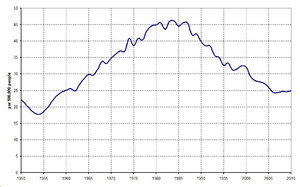Finno-Ugrian suicide hypothesis

The Finno-Ugrian suicide hypothesis proposes to link genetic ties originating among Finno-Ugric cultures and ethnicities to high rate of suicide, claiming an allele common among them is responsible.
Mari and Udmurts have been found to have a three times higher suicide rate than Finns and Hungarians. It has been thus theorized that such a possible allele may have arisen in those populations.
However, contrary to the hypothesis, available contemporary (1990–1994) suicide rates were uniformly negatively associated with these ancestry proportions. The findings of this first test outside Europe are therefore conflicting. A proposal based on the geographical study approach is offered to further the progress of investigations into the genetics of suicide.[2]
See also
References
- ↑ Suicide rate in Lithuania (WHO)
- ↑ Voracek M (2006). "Ancestry, genes, and suicide: a test of the Finno-Ugrian Suicide Hypothesis in the United States" (PDF). Percept Mot Skills. 103 (2): 543–50. doi:10.2466/pms.103.2.543-550. PMID 17165419.
- Voracek M, Loibl LM, Kandrychyn S (June 2007). "Testing the Finno-Ugrian suicide hypothesis: replication and refinement with regional suicide data from eastern Europe". Percept Mot Skills. 104 (3 Pt 1): 985–94. doi:10.2466/PMS.104.3.985-994. PMID 17688155.
- Voracek M, Fisher ML, Marusic A (October 2003). "The Finno-Ugrian suicide hypothesis: variation in European suicide rates by latitude and longitude". Percept Mot Skills. 97 (2): 401–6. doi:10.2466/pms.2003.97.2.401. PMID 14620226.